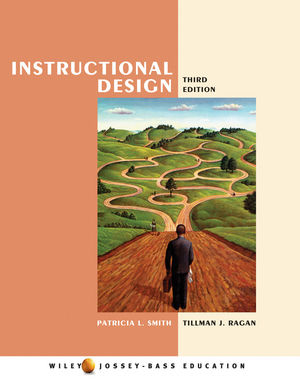|
Textbook
Instructional Design, 3rd EditionISBN: 978-0-471-39353-5
Paperback
400 pages
December 2004, ©2005
 This is a Print-on-Demand title. It will be printed specifically to fill your order. Please allow an additional 10-15 days delivery time. The book is not returnable.
|
||||||
I INTRODUCTION 1
CHAPTER 1 INTRODUCTION TO INSTRUCTIONAL DESIGN 3
Introduction 4
What Does Instructional Design Mean? 4
What is Design? 6
The Instructional Design Process 8
CHAPTER 2 FOUNDATIONS OF INSTRUCTIONAL DESIGN 17
Why Discuss Philosophy and Theory in an Instructional Design Text? 18
The Philosophical Perspectives of Instructional Design 18
What Is Theory? 23
Major Theory Bases Contributing to Instructional Design 23
II ANALYSIS AND ASSESSMENT 39
CHAPTER 3 INSTRUCTIONAL ANALYSIS: ANALYZING THE LEARNING CONTEXT 41
Overview of Analysis 42
Determining Instructional Needs 43
Describing the Learning Environment 49
Working with an Expert 52
CHAPTER 4 INSTRUCTIONAL ANALYSIS: ANALYZING THE LEARNERS 57
An Overview of Learner Analysis 58
Similarities and Differences between Learners 59
Changing Similarities 65
Significance of Types of Learner Characteristics 69
CHAPTER 5 INSTRUCTIONAL ANALYSIS: ANALYZING THE LEARNING TASK 75
Overview of Analysis of the Learning Task 76
Writing Learning Goals 77
Determining Types of Learning 78
Conducting an Information-Processing Analysis 83
Writing Learning Objectives 94
CHAPTER 6 ASSESSING LEARNING FROM INSTRUCTION 103
An Overview of Assessment of Learning from Instruction 104
Purposes of Evaluation 104
Purposes and Models of Assessment of Learners’ Achievement 105
Types of Assessments 107
Characteristics of Good Assessment Instruments 108
Formats of Assessment 112
Item Specifications 116
Assessment Instrument Blueprints 121
III INSTRUCTIONAL STRATEGIES 125
CHAPTER 7 A FRAMEWORK FOR INSTRUCTIONAL STRATEGY DESIGN 127
An Overview of Instructional Strategy Concerns in Instructional Design 128
Exercise A 128
Lesson-Level Organizational Strategies 129
Lessons and Learning Environments 131
Exercise B 140
Alternatives in Locus of Information Processing 141
Supplantive and Generative Strategies of Instruction 142
Types of Learning and Instructional Strategies 143
Exercise C 146
CHAPTER 8 STRATEGIES FOR DECLARATIVE KNOWLEDGE INSTRUCTION 151
Introduction 152
A Review of Declarative Knowledge Learning 152
Cognitive Processes of Learning Declarative Knowledge 153
Conditions Supporting Declarative Knowledge Learning and Example Lessons 156
Assessment of Declarative Knowledge 167
Exercises 167
CHAPTER 9 STRATEGIES FOR INSTRUCTION LEADING TO CONCEPT LEARNING 171
A Review of Concept Learning 172
Cognitive Processes and Structures in Concept Learning 173
Essential Conditions of Learning Concepts 175
Assessment of Concept Learning 180
Exercises 181
Examples Concept Lesson 182
CHAPTER 10 STRATEGIES FOR INSTRUCTION LEADING TO LEARNING PROCEDURES 188
A Review of Learning to Apply a Procedure 189
Cognitive Processes Involved in the Learning of Procedures 190
Conditions Supporting the Learning of Procedures 190
Asessment of Procedure Learning 197
Example Procedure Learning Lesson 198
Exercises 202
CHAPTER 11 STRATEGIES FOR INSTRUCTION LEADING TO PRINCIPLE LEARNING 204
A Review of Principle Learning 205
Exercises 206
Cognitive Processes of Learning Principles 206
Conditions Supporting Learning Principles 207
Assessment of Principle Application 211
Example Principle Application Lesson 212
CHAPTER 12 STRATEGIES FOR PROBLEM-SOLVING INSTRUCTION 217
A Review of Problem-Solving Learning 218
Cognitive Requirements of Problem-Solving Learning 219
Problem-Solving Task-Analysis 222
The Differences between Expert and Novice Problem Solvers 222
Instructional Events for a Problem-Solving Lesson 223
Assessment of Problem Solving Learning 227
Macrostrategies for Problem-Solving Instruction 228
Example Problem Solving Lesson 234
Exercise 237
CHAPTER 13 STRATEGIES FOR COGNITIVE STRATEGY INSTRUCTION 243
A Review of Cognitive Strategy Learning 244
Cognitive Requirements of Cognitive Strategy Learning 246
General Approaches to Teaching Cognitive Strategies 247
Events of Instruction for Teaching Cognitive Strategies 248
Impediments to Strategy Use 253
Assessment of Cognitive Strategy Learning 254
Exercise 255
CHAPTER 14 STRATEGIES FOR ATTITUDE LEARNING 259
Introduction 260
Instruction for Attitude Objectives 260
Exercise A 260
A Review of Attitude Learning 262
Exercise B 265
Example Attitude Lesson 265
Instructional Conditions for Attitude Objectives 265
Assessment of Attitude Learning 266
CHAPTER 15 STRATEGIES FOR PSYCHOMOTOR SKILL LEARNING 272
Introduction 273
A Review of Psychomotor Learning 273
Exercise A 275
Critical Elements of Psychomotor Skills 275
Exercise B 277
A General Procedure for Teaching Psychomotor Skills 279
Assessment of Psychomotor Skill Learning 281
CHAPTER 16 MACRO STRATEGIES: INTEGRATION OF TYPES OF LEARNING 285
Introduction 286
Curriculum Sequencing Structures 286
Exercise A 290
Integrative Curriculum Tools and Concepts 290
Alternative Views of Curriculum Design 293
Technology’s Assistance to Integrated Curriculum
Designs 295
Prescriptions for Curriculum Design 296
Exercise B 296
IV IMPLEMENTATION ,MANAGEMENT,AND EVALUATION 301
CHAPTER 17 IMPLEMENTATION 303
Overview of Implementation 304
What is Implementation? 304
What is the Role of Implementation in Instructional Design? 304
Importance of Considering Implementation 305
Timing of Implementation 305
Stages of the Adoption Process 305
Principles for Encouraging Implementation 306
An Approach to Facilitating Implementation: CBAM 307
Fidelity of Implementation 308
Adoption, Adaptation, and Integration 308
Embodiment as Implementation 309
Exercises 309
CHAPTER 18 MANAGEMENT OF INSTRUCTION 312
Overview of Management of Instruction 313
Why Should a Designer Know Project Management 313
Defining Project Management 313
Project Management in Instructional Design 314
Standards for Project Management 315
Project Integration Management 316
Project Scope Management 316
Project Time Management 316
Project Cost Management 318
Project Human Resource Management 318
Risk, Change, and Crisis Management 319
Macro-Level and Micro-Level Management Issues 320
Instructional Management 321
Integrated Learning Systems 321
Course Management Systems 322
Exercises 323
CHAPTER 19 FORMATIVE AND SUMMATIVE EVALUATION 326
Evaluating Instructional Materials 327
Overview of Formative Evaluation 327
Phases of Formative Evaluation 328
Exercises 341
An Overview of Summative Evaluation 342
Alternative Approaches to Summative Evaluation 343
Procedures for Summative Evaluation 344
V CONCLUSION 353
CHAPTER 20 CONCLUSIONS AND FUTURE DIRECTIONS 355
Overview 356
A Summary of the Major Principles Guiding Instructional Design 356
“Appropriate” Instructional Design 356
Resources 357
Criticality 358
Accountability 359
Expectations/Requirements of the Client Agency 359
Exercise A 363
What Instructional Designers Do 359
Future Directions for Instructional Design 364
New Assumptions 368
Exercise B 368
Author index 373
Subject index 377



